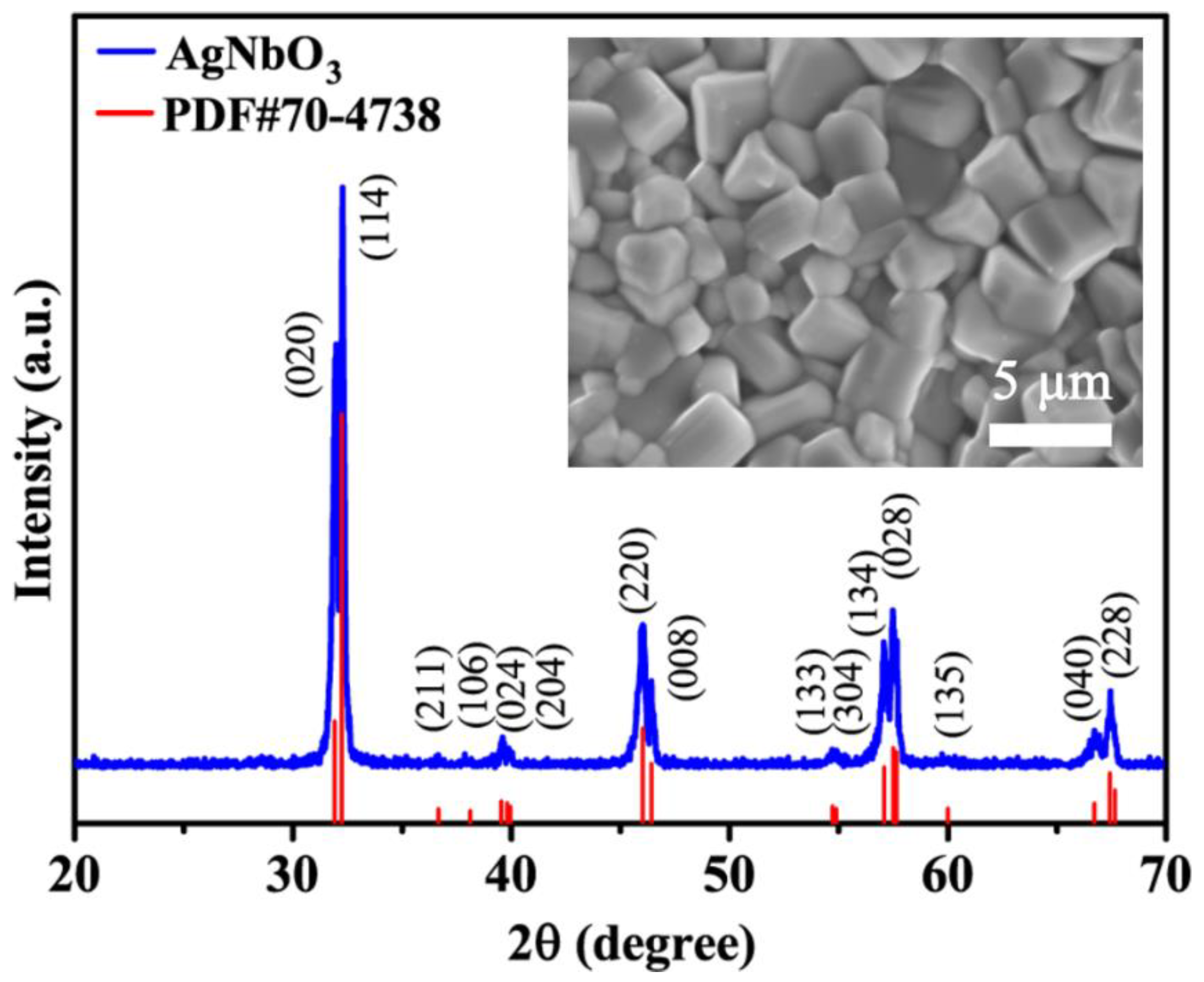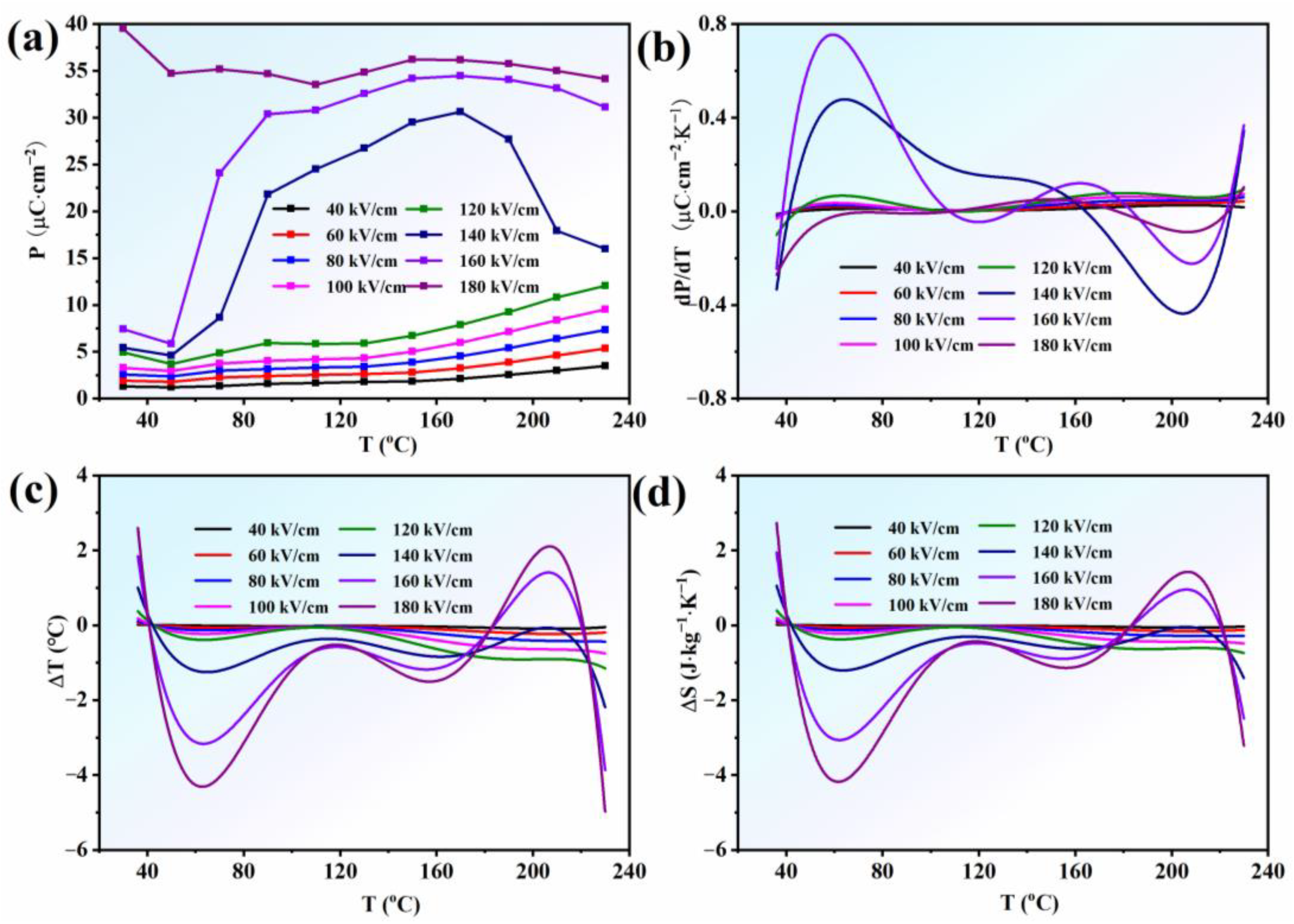Positive and Negative Electrocaloric Effect in Lead-Free Silver Niobate Antiferroelectric Ceramic Depending on Affluent Phase Transition
Abstract
:1. Introduction
2. Experimental Procedure
2.1. Fabrication
2.2. Characterization
3. Results and Discussion
4. Conclusions
Author Contributions
Funding
Institutional Review Board Statement
Informed Consent Statement
Data Availability Statement
Acknowledgments
Conflicts of Interest
References
- Greco, A.; Masselli, C. Electrocaloric Cooling: A Review of the Thermodynamic Cycles, Materials, Models, and Devices. Magnetochemistry 2020, 6, 67. [Google Scholar] [CrossRef]
- Li, J.; Li, J.; Wu, H.-H.; Qin, S.; Su, X.; Wang, Y.; Lou, X.; Guo, D.; Su, Y.; Qiao, L.; et al. Giant Electrocaloric Effect and Ultrahigh Refrigeration Efficiency in Antiferroelectric Ceramics by Morphotropic Phase Boundary Design. ACS Appl. Mater. Interfaces 2020, 12, 45005–45014. [Google Scholar] [CrossRef] [PubMed]
- Xavier, M.; Enric, S.-T.; Sam, C.; David, G.-A.; Sohini, K.-N.; Antoni, P.; Lluís, M.; Neil, D.M. Giant Electrocaloric Strength in Single-Crystal BaTiO3. Adv. Mater. 2013, 25, 1360–1365. [Google Scholar]
- Mischenko, A.S.; Zhang, Q.; Scott, J.F.; Whatmore, R.W.; Mathur, N.D. Giant electrocaloric effect in thin-film PbZr0.95Ti0.05O3. Science 2006, 311, 1270–1271. [Google Scholar] [CrossRef] [Green Version]
- Qian, X.S.; Ye, H.J.; Zhang, Y.T.; Gu, H.; Li, X.; Randall, C.A.; Zhang, Q.M. Giant Electrocaloric Response Over A Broad Temperature Range in Modified BaTiO3 Ceramics. Adv. Funct. Mater. 2014, 24, 1300–1305. [Google Scholar] [CrossRef]
- Bai, Y.; Zheng, G.; Shi, S. Direct measurement of giant electrocaloric effect in BaTiO3 multilayer thick film structure beyond theoretical prediction. Appl. Phys. Lett. 2010, 96, 192902. [Google Scholar] [CrossRef] [Green Version]
- Scott, J.F. Electrocaloric Materials. Annu. Rev. Mater. Res. 2011, 41, 229–240. [Google Scholar] [CrossRef]
- Ponomareva, I.; Lisenkov, S. Bridging the Macroscopic and Atomistic Descriptions of the Electrocaloric Effect. Phys. Rev. Lett. 2012, 108, 167604. [Google Scholar] [CrossRef] [Green Version]
- Li, B.; Wang, J.B.; Zhong, X.L.; Wang, F.; Zeng, Y.K.; Zhou, Y.C. The coexistence of the negative and positive electrocaloric effect in ferroelectric thin films for solid-state refrigeration. EPL 2013, 102, 47004. [Google Scholar] [CrossRef]
- Peräntie, J.; Hagberg, J.; Uusimäki, A.; Jantunen, H. Field-induced thermal response and irreversible phase transition enthalpy change in Pb(Mg1/3Nb2/3)O3-PbTiO3. Appl. Phys. Lett. 2009, 94, 102903. [Google Scholar] [CrossRef] [Green Version]
- Uddin, S.; Zheng, G.-P.; Iqbal, Y.; Ubic, R.; Yang, J. Unification of the negative electrocaloric effect in Bi1/2Na1/2TiO3-BaTiO3 solid solutions by Ba1/2Sr1/2TiO3 doping. J. Appl. Phys. 2013, 114, 213519. [Google Scholar] [CrossRef]
- Lu, S.G.; Zhang, Q. Electrocaloric Materials for Solid-State Refrigeration. Adv. Mater. 2009, 21, 1983–1987. [Google Scholar] [CrossRef]
- Moya, X.; Kar-Narayan, S.; Mathur, N.D. Caloric materials near ferroic phase transitions. Nat. Mater. 2014, 13, 439–450. [Google Scholar] [CrossRef]
- Guo, F.; Wu, X.; Lu, Q.; Zhao, S. Near room temperature giant negative and positive electrocaloric effects coexisting in lead–free BaZr0.2Ti0.8O3 relaxor ferroelectric films. Ceram. Int. 2018, 44, 2803–2808. [Google Scholar] [CrossRef]
- Zhuo, F.P.; Li, Q.; Gao, J.H.; Ji, Y.J.; Yan, Q.F.; Zhang, Y.L.; Wu, H.H.; Xi, X.Q.; Chu, X.C.; Cao, W.W. Giant Negative Electrocaloric Effect in (Pb,La)(Zr,Sn,Ti)O3 Antiferroelectrics Near Room Temperature. ACS Appl. Mater. Interfaces 2018, 10, 11747–11755. [Google Scholar] [CrossRef] [PubMed]
- Niu, Z.-H.; Jiang, Y.-P.; Tang, X.-G.; Liu, Q.-X.; Li, W.-H.; Lin, X.-W.; Lu, S.-G. Giant negative electrocaloric effect in B-site non-stoichiometric (Pb0.97La0.02)(Zr0.95Ti0.05)(1+y)O3 anti-ferroelectric ceramics. Mater. Res. Lett. 2018, 6, 384–389. [Google Scholar] [CrossRef] [Green Version]
- Francombe, M.H.; Lewis, B. Structural and Electrical Properties of Silver Niobate and Silver Tantalate. Acta Cryst. 1958, 11, 175–178. [Google Scholar] [CrossRef]
- Kania, A.; Roleder, K.; Łukaszewski, M. The Ferroelectric Phase in AgNbO3. Ferroelectrics 1984, 52, 265–269. [Google Scholar] [CrossRef]
- Tendeloo, G.V.; Verwerft, M.; Landuyt, J.V.; Coene, W.; Amelinckx, S. Trial Model for the Tilting Scheme in AgNbO3 Derived by Electron Diffraction and Imaging. Phys. Status Solidi (a) 1988, 109, 67–78. [Google Scholar]
- Fu, D.S.; Endo, M.; Taniguchi, H.; Taniyama, T.; Itoh, M. AgNbO3: A lead-free material with large polarization and electromechanical response. Appl. Phys. Lett. 2007, 90, 252907. [Google Scholar] [CrossRef]
- Levin, I.; Krayzman, V.; Woicik, J.C.; Karapetrova, J.; Proffen, T.; Tucker, M.G.; Reaney, I.M. Structural changes underlying the diffuse dielectric response in AgNbO3. Phys. Rev. B 2009, 79, 104113. [Google Scholar] [CrossRef] [Green Version]
- Levin, I.; Woicik, J.C.; Llobet, A.; Tucker, M.G.; Krayzman, V.; Pokorny, J.; Reaney, I.M. Displacive Ordering Transitions in Perovskite-Like AgNb1/2Ta1/2O3. Chem. Mater. 2010, 22, 4987–4995. [Google Scholar] [CrossRef]
- Li, G.; Liu, H.; Zhao, L.; Gao, J.; Li, J.F.; Yu, R.; Zhu, J. Atomic-scale structure characteristics of antiferroelectric silver niobate. Appl. Phys. Lett. 2018, 113, 242901. [Google Scholar] [CrossRef]
- Tian, Y.; Jin, L.; Zhang, H.F.; Xu, Z.; Wei, X.Y.; Politova, E.D.; Stefanovich, S.Y.; Tarakina, N.V.; Abrahams, I.; Yan, H.X. High energy density in silver niobate ceramics. J. Mater. Chem. A 2016, 4, 17279–17287. [Google Scholar] [CrossRef]
- Zhao, L.; Liu, Q.; Gao, J.; Zhang, S.; Li, J.F. Lead-Free Antiferroelectric Silver Niobate Tantalate with High Energy Storage Performance. Adv. Mater. 2017, 29, 1701824. [Google Scholar] [CrossRef]
- Xu, C.H.; Fu, Z.Q.; Liu, Z.; Wang, L.; Yan, S.G.; Chen, X.F.; Cao, F.; Dong, X.L.; Wang, G.S. La/Mn Co-doped AgNbO3 Lead-Free Antiferroelectric Ceramics with Large Energy Density and Power Density. ACS Sustain. Chem. Eng. 2018, 6, 16151–16159. [Google Scholar] [CrossRef]
- Zhao, L.; Gao, J.; Liu, Q.; Zhang, S.; Li, J.F. Silver Niobate Lead-Free Antiferroelectric Ceramics: Enhancing Energy Storage Density by B-Site Doping. ACS Appl. Mater. Interfaces 2018, 10, 819–826. [Google Scholar] [CrossRef]
- Lu, Z.; Bao, W.; Wang, G.; Sun, S.-K.; Li, L.; Li, J.; Yang, H.; Ji, H.; Feteira, A.; Li, D.; et al. Mechanism of enhanced energy storage density in AgNbO3-based lead-free antiferroelectrics. Nano Energy 2021, 79, 105423. [Google Scholar] [CrossRef]
- Luo, N.; Tang, X.; HAN, K.; Ma, L.; Chen, Z.; Chen, X.; Feng, Q.; Hu, C.; Wei, Y.; Toyohisa, F. Silver stoichiometry engineering: An alternative way to improve energy storage density of AgNbO3-based antiferroelectric ceramics. J. Mater. Res. 2021, 36, 1067–1075. [Google Scholar] [CrossRef]
- Miga, S.; Kania, A.; Dec, J. Freezing of the Nb5+ ion dynamics in AgNbO3 studied by linear and nonlinear dielectric response. J. Phys. Condens. Matter 2011, 23, 155901. [Google Scholar] [CrossRef]
- Tian, Y.; Jin, L.; Hu, Q.; Yu, K.; Zhuang, Y.; Viola, G.; Abrahams, I.; Xu, Z.; Wei, X.; Yan, H. Phase transitions in tantalum-modified silver niobate ceramics for high power energy storage. J. Mater. Chem. A 2019, 7, 834–842. [Google Scholar] [CrossRef]
- Tan, X.L.; Ma, C.; Frederick, J.; Beckman, S.; Webber, K.G. The Antiferroelectric ↔ Ferroelectric Phase Transition in Lead-Containing and Lead-Free Perovskite Ceramics. J. Am. Ceram. Soc. 2011, 94, 4091–4107. [Google Scholar] [CrossRef]
- Yan, Z.N.; Zhang, D.; Zhou, X.F.; Zhang, M.; Zhang, L.D.; Zhang, H.F.; Xue, G.L.; Abrahams, I.; Yan, H.X. Investigation of transitions between the M-phases in AgNbO3 based ceramics. J. Mater. Chem. A 2021, 9, 3520–3529. [Google Scholar] [CrossRef]
- Yashima, M.; Matsuyama, S.; Sano, R.; Itoh, M.; Tsuda, K.; Fu, D.S. Structure of Ferroelectric Silver Niobate AgNbO3. Chem. Mater. 2011, 23, 1643–1645. [Google Scholar] [CrossRef]
- Sciau, P.; Kania, A.; Dkhil, B.; Suard, E.; Ratuszna, A. Structural investigation of AgNbO3 phases using x-ray and neutron diffraction. J. Phys. Condens. Matter 2004, 16, 2795. [Google Scholar] [CrossRef]
- Hiroki, M.; Ayako, K.; Takafumi, O.; Craig, A.J.F.; Akihide, K.; Kazuki, S.; Fu, D.S. Polarization fluctuations in the perovskite-structured ferroelectric AgNbO3. Phys. Rev. B 2018, 97, 224104. [Google Scholar]
- Correia, T.; Zhang, Q. Electrocaloric Materials in Engineering Materials; Springer: Berlin/Heidelberg, Germany, 2014. [Google Scholar]
- Tuttle, B.A.; Payne, D.A. The effects of microstructure on the electrocaloric properties of Pb(Zr,Sn,Ti)O3 ceramics. Ferroelectrics 1981, 37, 603–606. [Google Scholar] [CrossRef]
- Yang, J.; Zhao, Y.; Lou, X.; Wu, J.; Hao, X. Synergistically optimizing electrocaloric effects and temperature span in KNN-based ceramics utilizing a relaxor multiphase boundary. J. Mater. Chem. C 2020, 8, 4030–4039. [Google Scholar] [CrossRef]
- Zhao, Y.; Du, J.; Yang, J.; Zhu, L.; Wang, Y.; Li, Y.; Hao, X. Large Room-Temperature Electrocaloric Response Realized in Potassium-Sodium Niobate by a Relaxor Enhancement Effect and Multilayer Ceramic Construct. ACS Appl. Mater. Interfaces 2022, 14, 11626–11635. [Google Scholar] [CrossRef]
- Geng, W.P.; Liu, Y.; Meng, X.J.; Laurent, B.; James, F.S.; Brahim, D.; Anquan, J. Giant Negative Electrocaloric Effect in Antiferroelectric La-Doped Pb(ZrTi)O3 Thin Films Near Room Temperature. Adv. Mater. 2015, 27, 3165–3169. [Google Scholar] [CrossRef]





Disclaimer/Publisher’s Note: The statements, opinions and data contained in all publications are solely those of the individual author(s) and contributor(s) and not of MDPI and/or the editor(s). MDPI and/or the editor(s) disclaim responsibility for any injury to people or property resulting from any ideas, methods, instructions or products referred to in the content. |
© 2023 by the authors. Licensee MDPI, Basel, Switzerland. This article is an open access article distributed under the terms and conditions of the Creative Commons Attribution (CC BY) license (https://creativecommons.org/licenses/by/4.0/).
Share and Cite
Du, J.; Zhao, Y.; Li, Y.; Sun, N.; Hao, X. Positive and Negative Electrocaloric Effect in Lead-Free Silver Niobate Antiferroelectric Ceramic Depending on Affluent Phase Transition. Crystals 2023, 13, 86. https://doi.org/10.3390/cryst13010086
Du J, Zhao Y, Li Y, Sun N, Hao X. Positive and Negative Electrocaloric Effect in Lead-Free Silver Niobate Antiferroelectric Ceramic Depending on Affluent Phase Transition. Crystals. 2023; 13(1):86. https://doi.org/10.3390/cryst13010086
Chicago/Turabian StyleDu, Jinhua, Ye Zhao, Yong Li, Ningning Sun, and Xihong Hao. 2023. "Positive and Negative Electrocaloric Effect in Lead-Free Silver Niobate Antiferroelectric Ceramic Depending on Affluent Phase Transition" Crystals 13, no. 1: 86. https://doi.org/10.3390/cryst13010086





